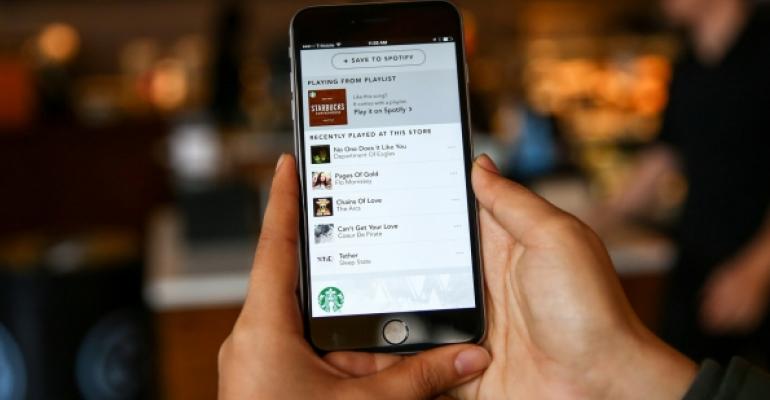Starbucks Corp. is processing about 6 million mobile orders and payments per month in the U.S., indicating that customers have embraced the ability to use their smartphones to interact with the coffeehouse brand, the company said Thursday.
After reporting Thursday a 9-percent increase in same-store sales for the Americas region, which includes the U.S., during the first quarter ended Dec. 27, Starbucks executives said about 21 percent of U.S. transactions were paid using mobile apps, and that rate was accelerating in January.
For the month of December, more than 1 million customers used mobile ordering and payment features on the Starbucks app. Those customers averaged about five mobile orders in the month, said Kevin Johnson, Starbucks president and chief operating officer.
The trend was even more apparent at the busiest Starbucks units, where morning peak demand is high, he said. Mobile ordering and payment accounted for about 10 percent of transactions at those locations.
“And we have just scratched the surface,” Johnson said.
Mobile ordering and payment has helped drive trial of new food items, which has boosted Starbucks’ investment in building new visit occasions beyond morning coffee.
Johnson said the morning daypart saw the strongest growth in five years, with food revenues rising nearly 20 percent over last year, contributing 3 percent to same-store sales.
Breakfast sandwich sales increased more than 40 percent year-over-year, but Bistro Box lunch sales grew 65 percent during the quarter. The company continues to roll out evening meal options, with the addition of beer and wine at some locations.
In 2016, mobile ordering and payment will expand further with the addition of delivery, now in test in New York and Seattle.
“We are learning many new things that will help us shape the future of delivery,” Johnson said of the test.
A key element of the mobile app is its integration with the My Starbucks Rewards program, which had 11.1 million members in the U.S. in the first quarter, an increase of 23 percent over a year ago, Johnson said.
This year, Starbucks plans to add more personalized suggested selling to loyal customers using the mobile app, and the ability to earn Star rewards in “new and exciting” ways, although Johnson did not reveal details. Starbucks loyalty members can now earn rewards by using Spotify, buying a New York Times subscription or using the ride-sharing service Lyft.
Mobile ordering and payment will also be brought to international markets, and has already been rolled out to the U.K. and Canada.
Howard Schultz, Starbucks chairman and CEO, said he has high hopes for the adoption of mobile ordering and payment in China, where he predicted it would be a “runaway success.”
“The adoption that we believe we are going to have in China is going to be more significant and quicker than it has been in the U.S., which already has stunned us in terms of how quickly the U.S. customer has embraced it,” Schultz said. “Technology is embedded in the Chinese consumer’s life.”
Schultz also reiterated Starbucks’ commitment to China, where the chain has nearly 2,000 locations in almost 100 cities, and is on track to reach 3,400 units by 2019.
Same-store sales in the China/Asia Pacific region rose 5 percent during the first quarter, slowing from double-digit increases the prior year. But it was also the first quarter the region included the addition of Starbucks Japan in its same-store sales base.
Concerns about economic stability in China have some investors nervous about Starbucks’ exposure, but Schultz, who recently visited Asia, said he is convinced that the Chinese government’s commitment to true economic reform is “genuine,” and will result in a middle class of 600 million Chinese people, nearly twice the size of the entire U.S. population, he noted.
“The buffeting the China economy is taking is necessary for it to move to its next stage of development,” Schultz said. “Starbucks has always and will continue to play the long game.”
The modest 1-percent same-store sales gain in the Europe, Middle East and Africa, or EMEA, region was dampened by the terrorist attacks in Paris, which affected Starbucks locations throughout Europe.
However, Johnson noted that business before the attacks was strong, and the region is already showing signs of recovery.
Contact Lisa Jennings at [email protected]
Follow her on Twitter: @livetodineout





